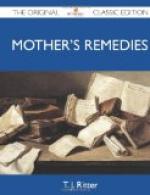The Embryo or impregnated egg is nourished in the womb by measures preparing for it. The placenta or after-birth forms during the third month of pregnancy. Its function is to furnish nourishment breathing (respiration) and excreting power to the embryo or impregnated egg. The fully developed after-birth is a roundish spongy mass with a diameter of about eight inches and weighs about one pound. It is usually thickest at the center, the edges thinning out to the membranes. The inner surface is smooth and glistening and is covered by a membrane (amnion) and beneath this two arteries and a vein branch in all directions.
The cord is attached to the inner surface of the after-birth and is of a glistening white color, varying in thickness, and is about twenty-two inches long, but it may be longer or shorter. It contains two arteries and a vein, which run in a somewhat spinal course.
Development at different months.—
First month.—There are indications of the eyes, mouth and anus. The extremities are rudimentary. The heart is 4/10 of an inch long.
Second month.—It is now about one inch long. The eyes, nose and ears can be distinguished. External genitals. There are suggestions of the hands and feet.
[516 Mothers’ remedies]
Third month.—The ovum is now the size of a goose-egg. Fingers and toes separate, nails look like fine membranes. The neck separates the head from the body. The sex can now be told. Length is five inches. Weight about 460 grains.
Fourth month.—Six inches long and now weighs 850 grains. Short hairs are present. Head equal to about one-fourth entire body. May perceive quickening.
Fifth month.—Ten inches long; weighs eight ounces. Eyelids begin to separate. Heart sounds can be heard. Quickening takes place.
Sixth month.—Twelve inches long; weighs 23-1/2 ounces. There is hair on the head, eyebrows and eyelashes are present. Testicles show near the abdominal rings (openings).
Seventh month.—Fifteen inches long; weight 41-1/2 ounces. Pupillary membrane disappears.




